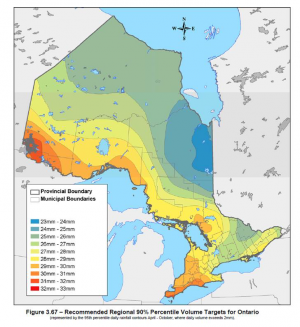Difference between revisions of "Runoff volume control targets"
Jump to navigation
Jump to search
Jenny Hill (talk | contribs) m |
Jenny Hill (talk | contribs) m |
||
| Line 2: | Line 2: | ||
Runoff Volume Control Target (RVC<sub>T</sub>) | Runoff Volume Control Target (RVC<sub>T</sub>) | ||
{{textbox|1="The means to achieve the RVC<sub>T</sub> includes:<br> | {{textbox|1="The means to achieve the RVC<sub>T</sub> includes:<br> | ||
| − | '''Retention''' - where the captured volume shall be ultimately [[infiltration|infiltrated]], [[Evapotraspiration|evapotranspired]] or [[Rainwater harvesting|re-used]] and the specified volume will not later be discharged to sewer networks (with the exception of internal water re-use activities) or surface waters and does not therefore become runoff, and | + | '''Retention''' - where the captured volume shall be ultimately [[infiltration|infiltrated]], [[Evapotraspiration|evapotranspired]] or [[Rainwater harvesting|re-used]] and the specified volume will not later be discharged to sewer networks (with the exception of internal water re-use activities) or surface waters and does not therefore become runoff, and |
| + | |||
'''Volume Capture and Treatment''' - Also referred to as `treatment and release`, where the volume capture and treatment directly aims at reducing surface water impairment through treatment of the specified volume, often referred to as a “water quality volume”.<ref>MOECC (2018)</ref>}} | '''Volume Capture and Treatment''' - Also referred to as `treatment and release`, where the volume capture and treatment directly aims at reducing surface water impairment through treatment of the specified volume, often referred to as a “water quality volume”.<ref>MOECC (2018)</ref>}} | ||
| − | + | ---- | |
Revision as of 14:39, 17 October 2017
Runoff Volume Control Target (RVCT)
"The means to achieve the RVCT includes:
Retention - where the captured volume shall be ultimately infiltrated, evapotranspired or re-used and the specified volume will not later be discharged to sewer networks (with the exception of internal water re-use activities) or surface waters and does not therefore become runoff, and
Volume Capture and Treatment - Also referred to as `treatment and release`, where the volume capture and treatment directly aims at reducing surface water impairment through treatment of the specified volume, often referred to as a “water quality volume”.[1]
- ↑ MOECC (2018)
